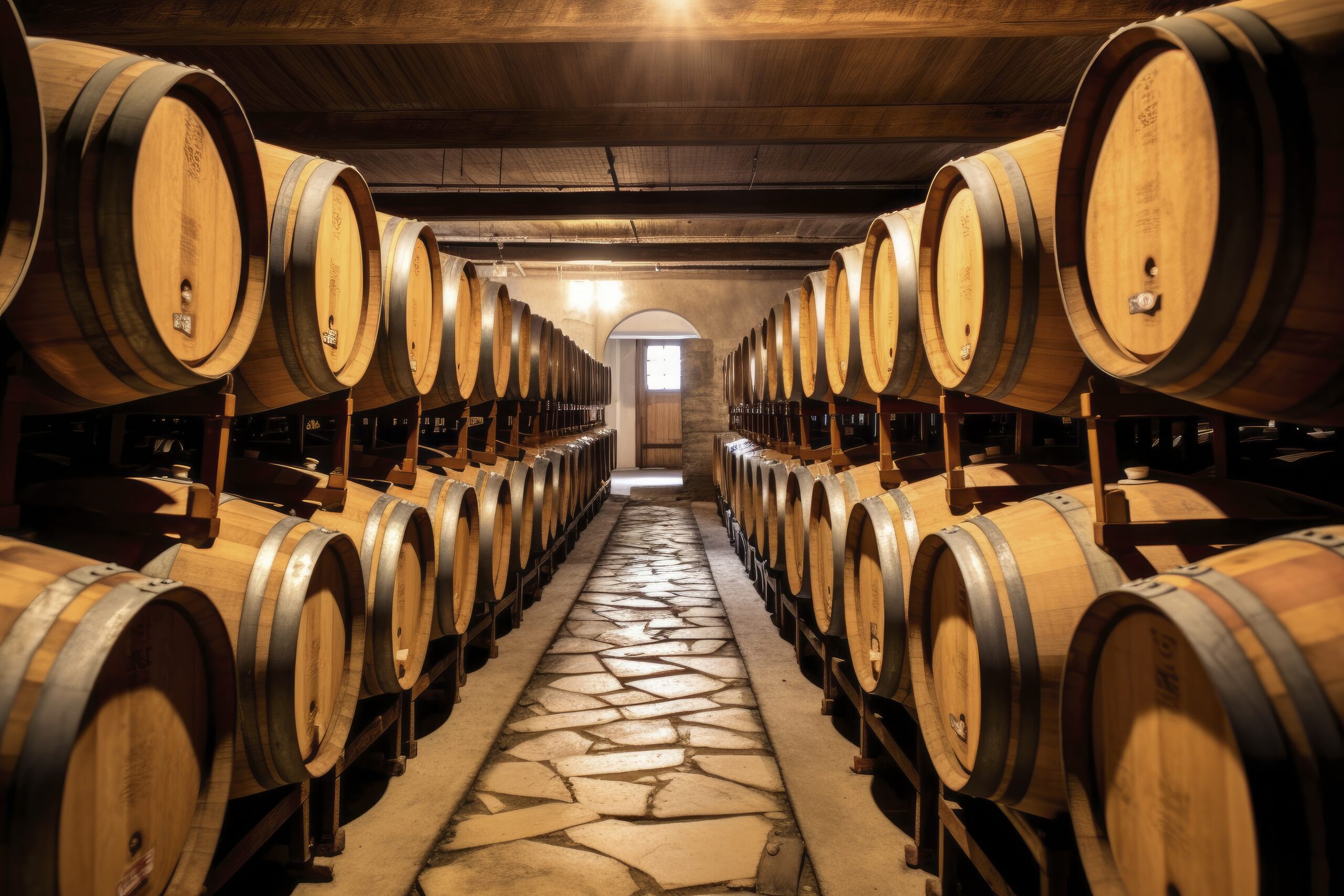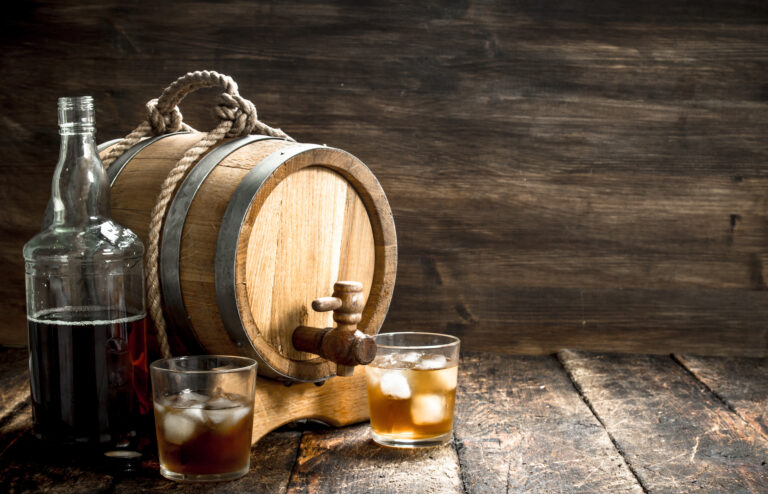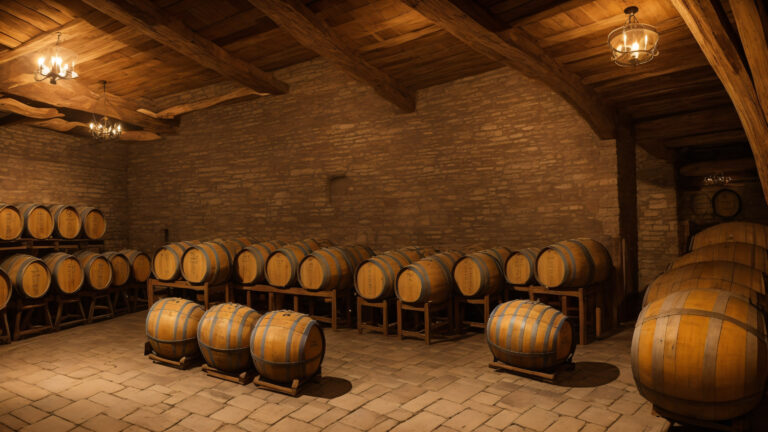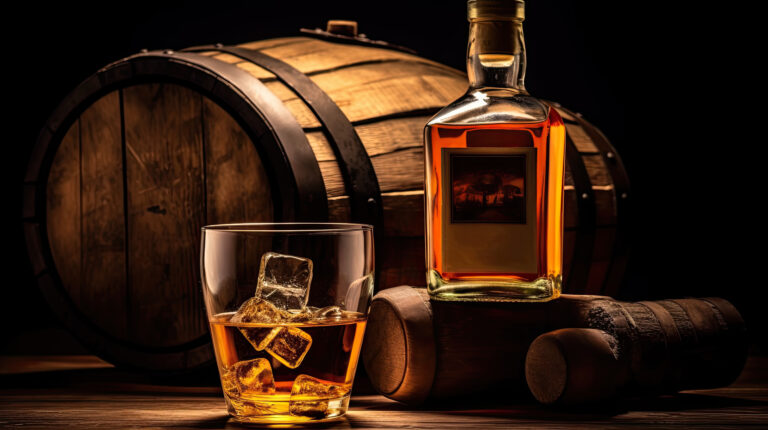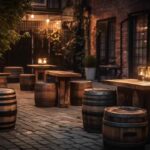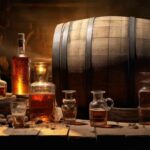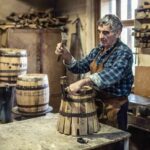Ever wonder how that amber nectar, whiskey, gains its signature character as it slumbers in wooden barrels? The fascinating secret lies within the intricate microbiology thriving inside those staves. Over years of maturation, a diverse community of microbes diligently feasts on the alcohol and organic compounds, slowly coaxing the raw spirit into a smooth, complex elixir. This bustling ecosystem of yeasts, bacteria, and fungi orchestrates a symphony of flavors that meld and deepen over time, culminating in the recognizable and beloved whiskey taste.
While the aging of whisky undeniably involves chemical reactions, the role of microbiology is even more profound. The very structure of the wooden barrels fosters the growth of specific microbes, with the oak itself contributing its own unique flavor compounds. Furthermore, ambient microbes from the surrounding environment inevitably find their way into the barrels, perhaps hitching a ride on airborne dust or the hands of distillery workers. Once inside, they settle in and get to work.
This hidden, microscopic realm within whiskey barrels is a veritable boozy paradise for countless microorganisms, and their activities, in turn, create a paradise for your taste buds. The aging process can span years, even decades, but when you finally savor a sip of that patiently matured whisky, you’ll gain a newfound appreciation for the intricate flavors crafted one tiny microbe at a time.
An Introduction to Whiskey Barrel Microbiology
The wood of whiskey barrels harbors a vibrant community of bacteria and yeast that engage in a fascinating dance with the spirit during aging, giving rise to a spectrum of complex flavors. As the whisky slowly permeates the wood, these microscopic inhabitants break down compounds present in both the wood and the spirit, generating novel and flavorful chemical compounds.
The oak wood, the traditional choice for barrels, is rich in sugars, lignin, tannins, and phenolic compounds. When the whiskey comes into contact with the wood, bacteria and yeast transform these components into desirable flavor molecules such as vanillin (evoking vanilla), lactone (hinting at coconut), and furfural (reminiscent of almond).
The distilled whiskey itself contains congeners, including fusel alcohols, esters, and acids. The resident microbes actively modify these congeners into delightful fruity and floral esters, as well as intriguing spicy phenols. They also work to break down harsh tannins into smoother, less bitter compounds.
The specific types of bacteria and yeast that flourish within each barrel are influenced by a multitude of factors, including the wood type, the geographical origin of the tree, the prevailing weather conditions during aging, and the unique warehouse environment. Importantly, distillers cannot exert complete control over these microscopic populations, leading to subtle yet significant variations between individual barrels.
As whiskey ages, the population dynamics of these microbes shift and evolve in response to changing conditions such as alcohol level, oxygen exposure, and the availability of consumable compounds. In the early stages, bacteria often dominate, but as oxygen levels decrease within the barrel, anaerobic bacteria and yeast tend to take over.
The intricate interplay between the wood, the diverse microbes, the initial congeners in the spirit, and the surrounding environment within each barrel ensures that no two whiskeys are precisely alike, even those originating from the same distillery. Therefore, barrel-aging whiskey is as much an art, guided by experience and intuition, as it is a science.
Delving into the microbiology underpinning barrel-aging reveals whiskey as a dynamic, living spirit that undergoes a remarkable evolution shaped by its circumstances. This profound transformation into a distinct and flavorful drink is only made possible through the fascinating interaction of wood, microbes, and the patient passage of time.
The Role of Wood in Whiskey Barrel Flavor
The very wood from which whiskey barrels are crafted plays a pivotal role in the genesis of its characteristic flavor. For centuries, oak barrels have stood as the undisputed choice for aging whisky.
The Species of Oak
The two dominant oak species employed in barrel making are American white oak (Quercus alba) and European oak (Quercus robur). American white oak is known to impart notes of vanilla, coconut, and subtle spice. In contrast, European oak tends to contribute more robust flavors such as dried fruit, nuts, and even hints of chocolate.
Toast Level
The degree of “toast” applied to the wood during barrel construction also significantly influences the resulting flavor profile. The longer the wood is toasted, the darker it becomes, leading to the extraction of more complex flavors. A lighter toast often yields delicate vanilla and caramel notes. A medium toast can contribute flavors like spice, nut, and chocolate. A heavy toast, on the other hand, can impart rich molasses, coffee, and cocoa nuances.
Char Level
Following toasting, the interior of the barrel undergoes a charring process. This layer of char acts as a filter, helping to mellow the spirit. A deeper char results in bolder flavors as the wood’s lignin and hemicellulose break down, releasing vanillin and other flavorful compounds. A light char tends to impart delicate vanilla and coconut notes, while a heavy char contributes richer molasses, cocoa, and coffee characteristics.
The Microbiology
Crucially, the wood itself harbors a community of microbes that actively break down compounds within the spirit, generating flavorful esters and acids. Different distilleries may cultivate or favor specific strains of yeast, bacteria, and fungi that are best suited to their regional environment and desired whiskey style. The synergistic interplay between the wood’s chemistry and this microbial activity ultimately shapes the signature flavor profile of a particular whiskey brand.
In essence, the wood species, the level of toast, the depth of char, and the resident microbiology within the barrels all work in concert to create the intricate tapestry of flavors found in fine whiskies. So, the next time you savor your favorite whisky, take a moment to appreciate the craftsmanship and patience that went into its aging, a process deeply intertwined with the unseen world within the barrel.
Key Microbes Involved in Whiskey Barrel Aging
Several types of microbes play crucial roles in the barrel aging process, contributing to the complex and nuanced flavors found in whiskey.
Yeasts
Yeasts, such as Saccharomyces cerevisiae, are primarily known for their role in fermenting the distilled spirit into alcohol. However, even after distillation, residual yeast cells persist within the spirit and continue to influence its flavor development during barrel aging. These yeasts produce esters, which contribute delightful fruity notes reminiscent of apple, banana, and pear.
Bacteria
Various bacteria, including Lactobacillus and Acetobacter species, are also present in smaller quantities within the barrels. These bacteria produce lactic acid and acetic acid, which can contribute subtle sour and tangy flavors. The most well-known bacterium in whiskey aging is Acetobacter aceti, which produces acetic acid, the main component of vinegar, and in controlled amounts can add a touch of complexity.
Fungi
Fungi, including species of Aspergillus and Penicillium, can grow on the surface of the spirit during barrel aging. These fungi release enzymes that break down oak lactones from the barrel wood into whisky lactones, imparting characteristic woody, nutty, and creamy flavors. They can also produce other compounds that contribute earthy and slightly musty notes.
The specific types of microbes that thrive during barrel aging are influenced by factors such as the initial distillation proof, the barrel type, the environmental conditions of the warehouse, and the overall length of aging. Master distillers carefully manage these variables to cultivate the ideal microbial communities that will ultimately create their signature flavors. The harmonious interplay of yeasts, bacteria, and fungi, working in concert with the oak wood and the spirit, is what truly distinguishes the taste of fine, aged whisky.
How Microbes Influence Whiskey Flavor Compounds
Microbes are indispensable in the creation of the intricate flavors found in aged whiskey. As the spirit matures within charred oak barrels, microscopic bacteria and fungi actively consume compounds present in both the wood and the alcohol, giving rise to a diverse array of novel and flavorful molecules.
Wood Sugars and Extractives
The oak barrels naturally contain various wood sugars, starch, and other extractives that gradually leach into the whiskey during the aging process. Microbes readily metabolize these wood-derived compounds, converting them into a range of flavor molecules, including vanillin (responsible for the characteristic vanilla flavor) and syringaldehyde (contributing smoky and spicy nuances).
Ethanol and Congeners
Microbes also feed on the ethanol and other organic compounds, collectively known as congeners, present in the distilled spirit. As they metabolize the ethanol, they generate flavorful esters that impart delightful fruity aromas, as well as other molecules that introduce nutty, floral, and caramel-like flavors.
Barrel Char and Phenols
The charred inner surface of the barrels also provides sustenance for the resident microbes. They break down phenolic compounds present in the char to create distinctive smoky and spicy flavors, arising from molecules such as guaiacol, 4-methylguaiacol, and eugenol.
Acids and Aldehydes
Through various microbial processes, acids, aldehydes, and related compounds are formed, contributing tangy, nutty, and subtly baked notes. For instance, butyric acid can introduce hints of parmesan cheese, while benzaldehyde provides almond-like flavors.
The Aging Dance
The diverse populations of microbes residing within whiskey barrels engage in a complex biochemical dance that unfolds over years, and sometimes even decades, of aging. As environmental conditions within the barrel subtly shift, different microbes become more or less active, continuously releasing new flavor molecules that transform the spirit into an ever-evolving, multi-dimensional tapestry of tastes and aromas. This intricate interplay between microbes, wood, and whiskey is what ultimately crafts the signature flavor profiles of fine aged spirits.
Regional Differences in Whiskey Barrel Microbiomes
The specific microbes that colonize whiskey barrels during aging are significantly influenced by regional factors, including the prevailing climate, the surrounding environment, and the native wood species used for barrel construction.
Temperature
Warmer geographical regions typically exhibit more active microbial communities within their barrels. The elevated temperatures accelerate the chemical reactions that break down compounds in both the wood and the whiskey. This often results in the development of more complex and robust flavors in a shorter timeframe. Conversely, colder climates lead to slower microbial activity, meaning that aging whiskies in these regions often requires longer periods to achieve full flavor development.
Humidity
Areas with higher humidity provide more moisture, which is conducive to the thriving of microbes. The increased moisture levels support greater growth of yeasts, bacteria, and fungi within the barrels. Drier regions tend to limit microbial populations, which in turn can restrict the development of certain flavor compounds. However, drier conditions can also promote oxidation reactions, leading to the formation of desirable flavors like vanilla or caramel.
Wood Source
The specific type of wood used for crafting the barrels also profoundly impacts the microbiome. For example, barrels made from American oak in Kentucky will likely house different microbial communities compared to barrels made from Spanish oak in Scotland or Japanese oak in Taiwan. The inherent porosity, pH, and native chemical compounds found in each wood variety shape the types of microbes that can successfully inhabit the barrel.
Ultimately, the key regional factors that most significantly influence a whiskey’s barrel microbiome—and consequently its final flavor profile—are temperature, humidity, and the source of the wood. While distillers can exert control over certain aspects of the production process, much of what transpires during maturation is dependent on the environmental conditions and the natural materials provided. The resulting unique blend of yeasts, bacteria, and fungi is what imbues each whiskey from around the world with its own distinctive character.
The Impact of Char on Barrel Microbiology
The charred interior surface of whiskey barrels, a result of the charring process, creates an environment that is surprisingly conducive to the thriving of microbes. As the whiskey ages, these microscopic organisms play a vital role in the development of its complex flavor profile.
Porous Surface Area
The charred wood dramatically increases the internal surface area of the barrel, providing significantly more space for interaction between the microbes and the whiskey. The char creates a network of tiny fissures and cavities that allow the whiskey to penetrate deep into the wood. This enhanced porous surface area facilitates greater contact between the spirit and the wood, leading to more efficient extraction of flavor compounds.
Microbial Growth
The char also fosters ideal conditions for robust microbial growth, including various fungi, yeasts, and bacteria. These microorganisms feed on compounds present in both the wood and the whiskey, producing a diverse array of new flavor compounds as metabolic byproducts. Compounds like vanillin, lactones, and tannins are either released from the wood or modified by the microbes, imparting notes of vanilla, coconut, and spice. Some research suggests that specific oak-associated microbes may play a key role in the formation of whisky lactones, compounds that contribute a creamy coconut-like flavor.
Oxygen Exposure
The controlled exchange of oxygen that occurs as it permeates the barrel during aging also fuels the growth of certain microbes. Moderate and prolonged exposure to oxygen helps to create a balanced and complex flavor in the whiskey. However, excessive oxygen can lead to undesirable microbial growth, so distillers carefully manage oxygen levels during both the barreling and aging stages. It’s important to note that oxygen also drives other chemical reactions within the barrel that contribute to flavor development independent of microbial activity.
The specific composition of the microbial community within each barrel is unique, influenced by factors such as the wood type, the level of char, the type of whiskey, the distillery’s location, and the specific aging conditions. While our understanding of the complex microbial ecosystems within whiskey barrels is still evolving, it is clear that they play an integral role in shaping some of the distinctive flavors found in aged whiskies. The fascinating interplay between the wood, the microbes, oxygen, and the whiskey over extended periods results in a truly unique and irreplaceable spirit.
Optimizing Barrel Microbiomes for Flavor Development
Strategically managing the microbial communities that reside within whiskey barrels can significantly impact the development of flavor during the aging process. As whiskey interacts with the wood of the barrel, the barrel’s unique microbiome simultaneously interacts with the whiskey, subtly yet profoundly influencing its final flavor profile. Distillers and researchers are increasingly exploring methods to better understand and even guide the barrel microbiome to achieve specific and desirable flavor profiles.
Managing pH Levels
The pH level within the barrels plays a crucial role in determining which types of microbes can thrive. More acidic pH levels tend to favor the growth of certain bacteria, while more alkaline conditions can promote the proliferation of other microorganisms, such as fungi. By carefully adjusting the pH of the spirit before filling the barrels, distillers can selectively encourage the growth of microbial communities known to impart desired flavors. For instance, a more acidic environment might promote the formation of fruity esters.
Selecting for Specific Microbes
Beyond managing pH, distillers can also influence the microbial populations by controlling other environmental factors such as oxygen levels and temperature, and even by intentionally inoculating barrels with specific microbial cultures. For example, Lactobacillus bacteria are commonly associated with the production of fruity flavors. Brettanomyces yeast, known for creating complex, often “funky” and earthy flavors in beers, can also influence whiskey. By introducing microbes known to produce specific metabolic byproducts, distillers can exert a greater degree of control over the evolving flavor profile.
Scraping and Reusing Barrels
As barrels are used repeatedly for aging, the microbial communities within them naturally evolve and become more complex over time. When barrels are scraped or “shaved” to remove the inner charred layer, a significant portion of the established microbes is also removed. This “refreshed” barrel can then be re-inoculated to selectively cultivate a new microbial community and potentially develop different flavors. Some distillers will even scrape barrels multiple times to create progressively more intricate and nuanced flavor profiles.
Blending Barrels
The practice of blending the contents of barrels with distinct microbial profiles offers distillers another powerful tool for crafting more complex and balanced flavors. Barrels that have developed heavy, dark fruit notes, for example, might be blended with those imparting lighter, more floral characteristics. This blending process before bottling allows these diverse flavor contributions to marry and harmonize into a cohesive, multi-dimensional spirit. A deeper understanding of how to manipulate the barrel microbiome provides distillers with an invaluable tool for crafting their signature flavor profiles.
The Future of Whiskey Barrel Microbiology Research
The scientific exploration of whiskey barrel microbiology is a relatively nascent yet incredibly promising field of research. As scientists unravel the intricate communities of yeasts, bacteria, and other microbes that call barrels home, they are unlocking exciting opportunities for innovation within the whiskey industry. This deeper knowledge will empower distillers with greater control over flavor development and the ability to craft whiskies boasting truly distinctive and nuanced taste profiles.
Harnessing Microbial Communities
Specific species of yeasts and bacteria are now recognized as key players in the transformation of distilled spirits into aged whiskey. Researchers are actively working to identify the precise microorganisms that drive the maturation process. By meticulously understanding how different microbes influence the color, aroma, and flavor of the spirit, distillers will be able to fine-tune environmental conditions to favor the growth of specific microbial communities. This targeted approach could allow them to accentuate desirable characteristics, such as vibrant fruity esters or intriguing smoky phenols.
Designer Yeast Strains
The development of genetically engineered yeast strains represents another compelling avenue of research. Scientists now possess the capability to create yeast hybrids that combine desirable traits from multiple species. For instance, a custom-designed strain might exhibit the high ethanol tolerance of one yeast while simultaneously possessing the enhanced flavor compound production capabilities of another. The use of such designer yeast strains could grant distillers unprecedented control over the complex biochemical reactions that occur during barrel aging. However, the level of consumer acceptance regarding the use of genetically modified organisms in whiskey production remains an important consideration.
The Final Frontier
While oak barrels have served as the traditional vessel for whiskey maturation for centuries, the potential of alternative wood types, as well as variations in barrel sizes and shapes, remains largely unexplored. Different woods possess unique combinations of lignin, tannins, and other extractable compounds that can impart distinct and novel flavor profiles to the aging spirit. Similarly, variations in barrel size and the level of char can significantly influence the maturation process. As our understanding of the intricate interactions between wood and microbes deepens, innovative barrel designs may unlock entirely new creative possibilities for distillers and blenders. The future of whiskey barrel research is an open frontier, brimming with potential for groundbreaking discoveries.
Whiskey enthusiasts worldwide eagerly anticipate the emergence of new and complex flavors that will undoubtedly arise from this exciting field of research. While tradition will always hold a cherished place in the world of whisky, innovation in barrel aging promises to yield spirits that are as unique and nuanced as the microscopic communities that help create them. The golden age of whiskey may still be ahead!
Frequently Asked Questions About Whiskey Barrel Microbiology
Have you ever pondered the magic behind whiskey’s distinctive flavor as it gracefully ages? The captivating secret lies in the intricate dance between the whiskey, the very wood of the barrels, and the unseen world of microbes that call them home. Here are some of the most common questions surrounding this fascinating process.
Where do the microbes in whiskey barrels come from? The microbes are naturally present in the surrounding environment, including the wood used to construct the barrels, the ambient air within the barrelhouse, and even on the surfaces of the distillery equipment. Yeasts, bacteria, and other microscopic microorganisms find their way into the barrels during the filling process and subsequently settle in, ready to exert their influence on the whiskey during its maturation.
What do the microbes actually do to the whiskey? These tiny powerhouses actively break down various compounds present in the wood, releasing flavorful molecules that contribute notes of vanilla, caramel, and spice. They also work their magic on molecules already present within the distilled spirit, transforming them into delightful fruity esters and other congeners that contribute to the whiskey’s distinctive aroma and taste. Certain anaerobic bacteria can even produce intriguing nutty or slightly “funky” flavors when oxygen levels become limited within the barrel.
Are the microbes in natural harmony or competition? The answer is often both. Certain yeasts and bacteria can work together in a symbiotic manner, contributing to the production of desirable flavors. However, other microbes may compete for access to essential nutrients such as wood sugars, ethanol, and organic acids. The specific combination of cooperating and competing microbes within each individual barrel contributes to the unique flavor profile of a particular whiskey batch or bottling.
Do distillers try to control the microbes? Traditionally, distillers often adopted a more hands-off approach, allowing the natural processes to unfold. However, some modern distillers are now exploring methods to influence the microbial communities, such as inoculating barrels with specific yeast and bacteria cultures to guide fermentation and flavor development. Others manipulate environmental factors like humidity, temperature, and oxygen levels to favor the growth of certain microbes over others. Despite these advancements, the majority of distillers still primarily rely on the native microbial populations that naturally inhabit their barrelhouses, respecting the element of surprise and the unique character they impart.
The complex microbiology within whiskey barrels results in an ever-changing and ultimately unrepeatable alchemy. Each barrel essentially becomes its own self-contained ecosystem, teeming with microscopic life, and each batch of whiskey emerges with a distinctive personality shaped by the wood, the spirit, the passage of time, and the tiny creatures that inhabit this miniature world. Sampling the fruits of their labor is a treat for our senses and a testament to the wonders of nature.
Final Thoughts
So there you have it – an insightful glimpse into the intricate microbiology that underpins whiskey barrel aging and how it orchestrates the development of those distinctive flavors in the final spirit. The next time you savor a sip of a well-aged whisky, take a moment to appreciate the unseen chemical reactions and the bustling microscopic communities at work within the wood. Though invisible to the naked eye, their impact on the taste is undeniably profound. Mother Nature, in her own subtle way, is the ultimate artist, crafting a masterpiece of sight, smell, and flavor through the simple, natural aging of distilled spirits. It’s truly remarkable to consider the extent of transformation that occurs within those charred oak barrels over years and even decades. The patience required for crafting premium whiskey is indeed well rewarded. So go ahead, pour yourself another dram, and raise your glass to the mysterious microbes that make it all possible. Their work is done, and now it’s time for you to enjoy the exquisite fruits of their labor!
